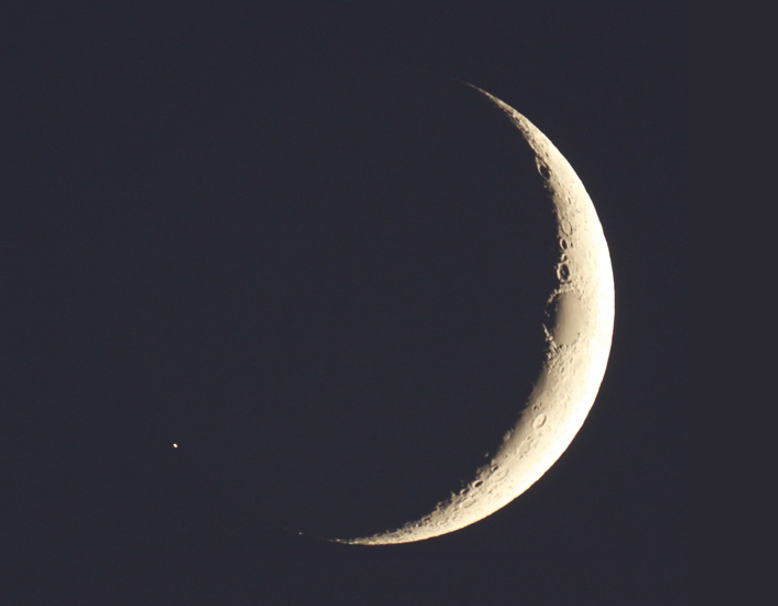Moving along the celestial sphere, the Moon arranges total, annular or partial solar eclipses at least twice a year. Much more often, it closes the stars — such phenomena are called occultations by astronomers. Similar to eclipses, these phenomena can be seen only on a limited part of the globe, and it is desirable that there be night or at least twilight at this time. But for occultations of the brightest luminaries of the zodiacal belt, having a brilliance of about the 1st magnitude, this is insignificant. Such an event awaits us on October 18: on this day our natural moon will close the star Antares (α Sco).
The plane of the lunar orbit is inclined to the earth by a little more than 5°. At first glance, this is not so much, but in fact it is 10 times larger than the average apparent diameter of the Moon in our sky. The straight line along which the orbital planes intersect is called the node line. If it were stationary, solar and lunar eclipses would occur on the same days every year, and our natural moon would constantly move against the background of the same stars. In fact, this line, under the influence of the gravity of the Sun and planets, slowly rotates from east to west (for observers of the Northern Hemisphere — from left to right). Therefore, the Moon covers a slightly different strip of the celestial sphere with each orbit.
Due to the inclination of the Moon’s orbit to the ecliptic, its shadow or penumbra does not fall on Earth every month but from 2 to 4 times a year
The sun, moving along the ecliptic, inevitably passes near the nodes of the v orbit from two to four times (very rarely — five times) every year, and at this time solar and lunar eclipses are visible from the Earth. It is somewhat more difficult with “fixed” stars. Occultations of those of them that are located near the ecliptic occur when one of the nodes is nearby. This happens about once every 9 years. In fact, since the Moon has a noticeable angular diameter (as already mentioned — about half a degree) and its “shadow” falls on a sufficiently large Earth, there is a certain range of the node’s distance from the celestial body at which our natural moon will cover it from ground observers. Therefore, occultations of such luminaries, the best example of which is Regulus (α Leo), occur in series lasting 1–2 years, separated by intervals of 7–8 years. In such a series, a star disappears behind the lunar disk every 27–28 days, but not all of these phenomena can be seen at a specific point on the globe.
It’s a little more complicated with stars lying far from the ecliptic. Most of the time, the projection of the Moon’s orbit on the celestial sphere lies far away from them, so no occultations occur. But then there comes a period when it passes almost the same part of the sky for quite a long time, and if there is an object on it, it will regularly “disappear” behind the lunar disk, and the duration of such a series can reach 5 years. And then comes the 13-year break…
This is exactly what happens with Antares, which, of all the bright zodiacal stars (including Aldebaran and Spica), lies furthest south of the celestial equator. Of course, this complicates its observation in our latitudes, but still, its occultations in Ukraine are visible from time to time, although not always in favorable conditions.
The previous series of Moon occultations of Antares ended on October 21, 2009. On that day, its occultation was visible in Kyiv, but at an altitude of less than 3° above the horizon. The current series began on August 24, 2023, when a rare event could be observed in the Western Hemisphere. On September 21, this star rose 3 hours after it appeared from behind the lunar disk in Ukraine, and finally, on October 18, we will be able to see the whole event from beginning to end. The problem is that in most of the Ukrainian territory, it will happen in a bright sky, even before sunset.

On this day, the moon will have the phase of a thin sickle and will cover Antares with its dark edge. Residents of Western Ukraine will notice it earlier than others: in Lviv, occultation will begin at 4.32 p.m. local time. In Kyiv, it will happen at 4:43 p.m., two minutes later — in Odesa, at 4:52 p.m. — in Kharkiv. Of course, it will be impossible to observe this phenomenon with the naked eye at a Sun height of 10-15°, but a telescope or binoculars with a magnification of 15-20 times and a lens diameter of more than 50 mm should be enough. The opening will take place in somewhat better conditions, especially in the east of the country, where our daylight will already have time to disappear over the horizon. The corresponding moment for Kharkiv is 6:01 p.m., for Odesa — 5:59 p.m., for Kyiv — 5:53 p.m. (in these two cities, the Sun will be less than a degree above the horizon). Finally, for Lviv, the appearance of a star is expected at 5:44 p.m., but the height of the Sun at this moment will exceed 5°. The time is indicated to the minute, because it will be different for different areas of cities.
To the west of Antares (less than 4 arcseconds from it) is a satellite star with a brightness of about 6th magnitude.It is not possible to see it separately from the “main” luminary with any telescope since it is lost in the powerful halo of the red giant and requires good optics with powerful magnification as well as almost ideal atmospheric conditions. This task is sometimes facilitated by the Moon, when a brighter component is still behind its disk, and a less bright one has already appeared. However, it is necessary for the appearance of stars to occur because of its dark edge. The corresponding configuration of celestial bodies on the territory of Ukraine will take place only on the night of April 12-13, 2028. And on August 27 of the same year, the current series of Antares occultations will end.
Follow us on Twitter to get the most interesting space news in time
https://twitter.com/ust_magazine


